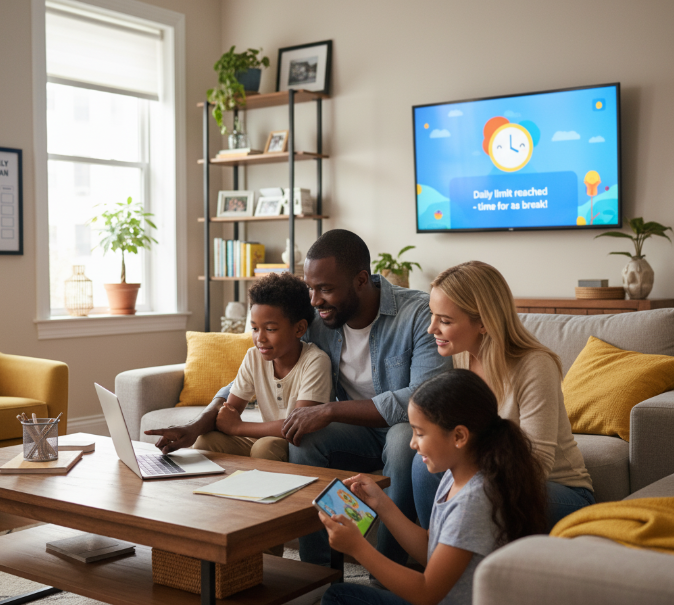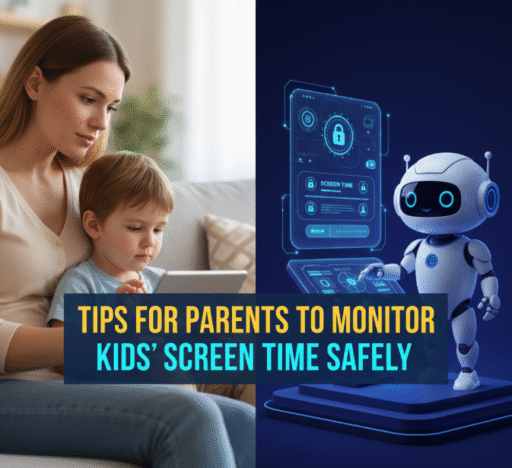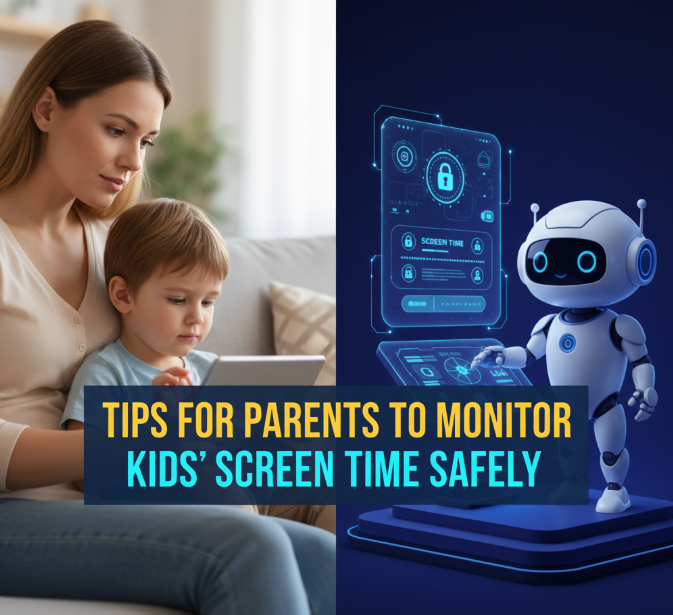Introduction
Screens are everywhere—TVs, tablets, smartphones, laptops, and even smartwatches. For kids, screens can be a source of fun, learning, and connection. But too much screen time can also affect their health, behavior, sleep, and even academic performance. That’s why parents today face a big challenge: how to monitor kids’ screen time safely without turning into the “bad guy.”
This article gives you practical, detailed, and family-friendly strategies to help balance screen use. You’ll learn how to create healthy boundaries, use smart tools, and guide your child toward responsible digital habits that last a lifetime.
Why Parents Need to Monitor Screen Time
Before we jump into strategies, let’s talk about why it’s important. Research shows that children in the U.S. spend an average of 7+ hours a day in front of screens, often for entertainment. That’s more than time spent on homework, exercise, or sleep!
Here are the key reasons parents should keep track of screen time:
-
Physical health risks: Too much screen time can cause eye strain, headaches, poor posture, and less physical activity.
-
Sleep problems: Blue light from devices affects melatonin, the hormone that helps kids sleep.
-
Behavioral issues: Increased aggression, irritability, or difficulty focusing often links to excessive gaming or social media use.
-
Online safety: Unmonitored screen time may expose kids to cyberbullying, predators, and inappropriate content.
-
Academic impact: Screen distraction reduces study time, lowers grades, and decreases productivity.
Practical Tips to Monitor Kids’ Screen Time Safely
1. Create Clear Family Rules
Children thrive when rules are simple and consistent. Instead of long lectures, make family guidelines about screen use.
Examples:
-
No phones at the dinner table.
-
Video games only after homework.
-
No screens 1 hour before bedtime.
-
Maximum of 2 hours daily recreational screen time.
👉 Pro tip: Write the rules on a “Family Media Agreement” poster and place it in a visible area.
2. Use Parental Control Tools and Apps
Technology can help you fight technology. Parental control tools let you track and limit screen use without constant arguments.
Top parental control apps to consider:
| App Name | Best For | Key Features |
|---|---|---|
| Qustodio | Overall monitoring | Time limits, app blocking, location tracking |
| Family Link | Google accounts (Android) | App approval, daily limits, activity reports |
| OurPact | iOS & Android | Scheduled app blocking, screen time allowance |
| Bark | Social media & messaging | Content alerts, monitoring texts & emails |
👉 Always explain to kids why you use these tools. Otherwise, they may feel spied on.
3. Set Screen-Free Zones in the House
Designate areas in your home where devices aren’t allowed. This reduces constant scrolling and encourages family interaction.
Ideas for screen-free zones:
-
Bedrooms (better sleep quality).
-
Dining area (family connection).
-
Bathrooms (safety and hygiene).
-
Study room (focus on learning).
4. Balance Screen Time with Offline Activities
Kids often use screens because they’re bored. Offering fun offline activities gives them healthier alternatives.
Engaging options:
-
Board games and puzzles.
-
Outdoor sports or bike rides.
-
Reading physical books.
-
Creative crafts (painting, building, cooking).
-
Family walks or gardening.
📊 Chart example: A balanced day for a child
| Activity | Hours Suggested |
|---|---|
| Sleep | 8–10 |
| School/homework | 6–7 |
| Screen entertainment | 1–2 |
| Physical activity | 1–2 |
| Family/social time | 2–3 |
| Hobbies/reading | 1–2 |
5. Model Healthy Digital Habits
Kids learn more from what you do than what you say. If you spend hours on your phone, they’ll copy you.
Ways to be a role model:
-
Keep your own screen time in check.
-
Avoid scrolling during meals.
-
Replace your phone with books or hobbies.
-
Talk openly about how you manage your digital life.
6. Teach Kids About Online Safety
Monitoring screen time isn’t only about hours spent—it’s also about what they see.
Teach your kids to:
-
Avoid chatting with strangers.
-
Never share personal details (address, school, phone number).
-
Report suspicious or harmful behavior.
-
Think before they post—digital footprints last forever.
7. Use the 20-20-20 Rule for Eye Protection
Staring at screens too long causes eye strain. Encourage kids to follow this simple rule:
-
Every 20 minutes,
-
Look at something 20 feet away,
-
For at least 20 seconds.
This keeps their eyes healthy and reduces headaches.

8. Encourage Screen Time for Learning, Not Just Entertainment
Not all screen time is bad! Some apps and websites promote creativity, problem-solving, and academic growth.
Examples of educational screen time:
-
Duolingo (language learning).
-
Khan Academy Kids (math, science, reading).
-
Scratch (coding for kids).
-
TED-Ed (educational videos).
👉 The key is guiding children toward quality content, not endless scrolling or gaming.
9. Involve Kids in Decision-Making
Instead of imposing strict rules, let kids have a voice. This reduces resistance and builds responsibility.
You can ask:
-
“How many hours do you think is fair for gaming?”
-
“What activities should we do instead of screens on weekends?”
-
“Which apps help you learn the most?”
When kids feel involved, they’re more likely to respect the rules.
10. Monitor, Don’t Micromanage
It’s tempting to constantly check what your child is doing online. But over-monitoring can hurt trust.
✅ Better approach: Be present without hovering.
-
Place screens in shared spaces (living room, not bedroom).
-
Occasionally check browsing history together.
-
Use monitoring apps transparently, not secretly.
Red Flags That Screen Time May Be a Problem
Sometimes, screen use goes beyond healthy limits. Watch for these warning signs:
-
Your child hides what they’re doing online.
-
Grades drop due to distraction.
-
They lose interest in outdoor play or hobbies.
-
Irritability when devices are taken away.
-
Staying up late with devices in bed.
If these happen regularly, it may be time to tighten rules or seek guidance from a counselor.
Extra Safety Tips for Parents
-
Use strong passwords: Prevent kids from bypassing controls.
-
Enable “Safe Search” filters: Block inappropriate content on browsers.
-
Check app ratings: Download only age-appropriate apps and games.
-
Update devices regularly: Keep security patches up-to-date.
-
Communicate daily: Ask kids what they enjoyed online and discuss any concerns.
Infographic Idea: A Balanced Digital Lifestyle for Kids
Visual Concept (for your design team):
A circle pie chart showing daily balance:
-
40% School & homework
-
25% Sleep
-
15% Family & hobbies
-
10% Physical activity
-
10% Screen entertainment
This helps kids see balance, not just hear about it.
Conclusion
Screens are part of modern childhood, but they don’t have to control it. By setting clear rules, using helpful tools, teaching digital safety, and being a positive role model, you can guide your kids toward safe, balanced screen use.
The goal isn’t to ban technology—it’s to teach children how to use it wisely. When parents stay involved with compassion and consistency, kids learn to enjoy the digital world without losing touch with the real one.
Final takeaway: Safe screen time isn’t about restriction; it’s about balance, awareness, and family connection.




